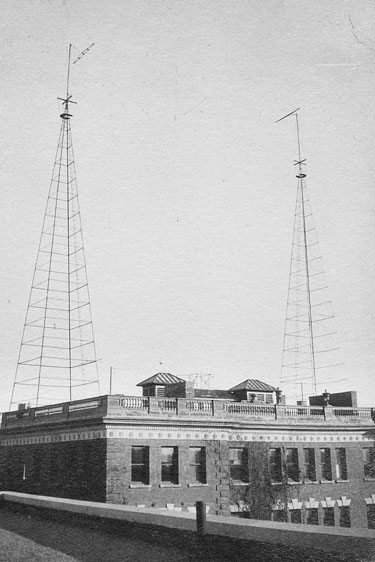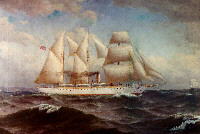|
Early Ham Radio Photographs-Page 2 |
|||
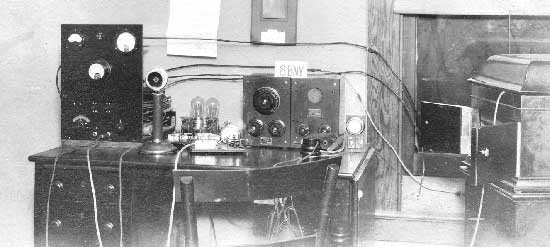 |
|||
| This page
features the activities of 8BNY (Robert H. Winchester, later W8BZR), originally of
Watertown, NY, and later Syracuse, NY. He received his first ham license in 1921, at the age of 15, and his station (circa 1922) is shown in the
picture above. Click
here,
or on the picture for a much larger view of his equipment.
Some of 8BNY licenses and other papers can be seen here. At the far left is the transmitter (also see the photo below). The receiver consists of a Westinghouse type RA tuner (3 dials), and a matching Westinghouse type DA detector and two-stage amplifier. Between the receiver and transmitter is a candlestick telephone carbon microphone driving a two-tube audio amplifier (which appears to use Federal transformers and UV-201 tubes). This was used for voice transmission, while a telegraph key (to the right of the microphone) was used for code (CW) operation. At the far right is a typical phonograph of the day. Most likely it was being used as a loudspeaker (note the wire emerging from the lid), using a driver unit that could be substituted for the phonograph's original reproducer. It is also possible that an electric pickup was being used to allow the broadcasting of recorded music, something early hams often did. It was unusual for a beginning ham, especially one in his teens, to have been fortunate enough to afford a factory-built receiver (which cost about $150 without tubes). His house, seen below, was a modest one, so this was no rich kid. He must have worked many long hours to be able to buy this equipment. |
|||
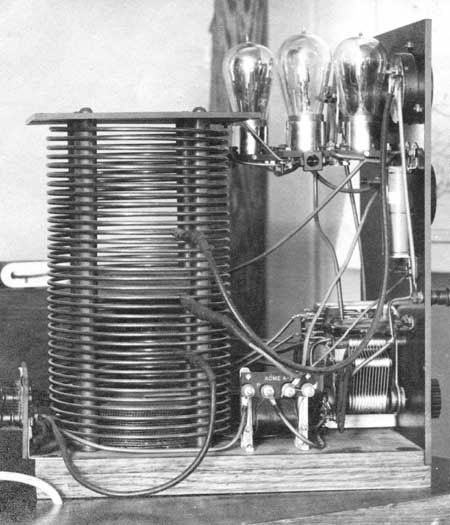 |
|||
|
The picture above shows 8BNY's transmitter as seen from the left side. It is obviously a homebrew. It was listed in government call books as having a power output of 50 watts. The tubes are some combination of UV-202's and (possibly) UV-216's as rectifiers. The power transformer is visible in the overall station photograph (at the right side of the transmitter). His back-yard antenna can be seen below. |
|||
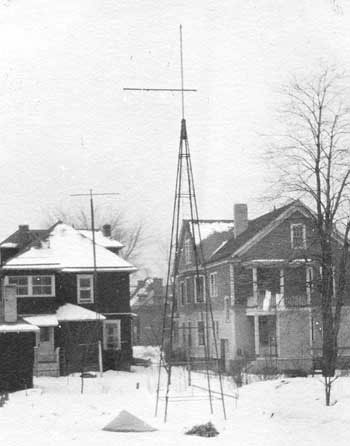 |
|||
|
Early in 1922, 8BNY used this equipment in a series of experimental broadcasts of sermons delivered by the pastor of a local church (see the clipping below from the Binghampton Press issue of March 3, 1922). |
|||
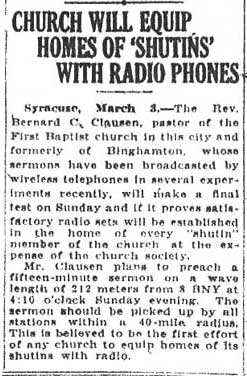 |
|||
| Many thanks to radio historian David Frost for this clipping! | |||
|
According to some correspondence that came with the photographs, these experiments came to the attention of the Bureau of Navigation (part of the Department of Commerce), which had jurisdiction over such activities at the time. Apparently, they took a dim view of what 8BNY was doing, and told him that to continue, he would have to restrict operation to a specific wavelength (360 meters), he would have to acquire a second class commercial operator's license, and the equipment would have to be subject to approval by a government inspector. There is no indication that he did this, so it appears that 8BNY's broadcasting operations came to an end at that point. |
|||
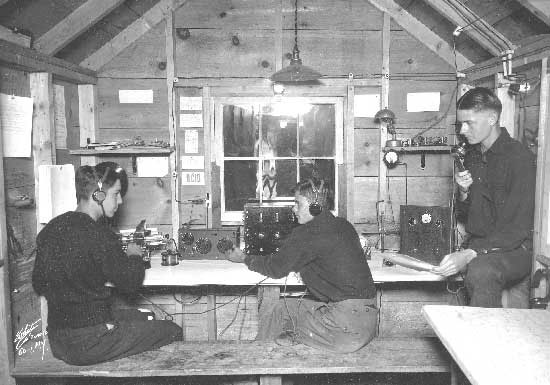 |
|||
| I
don't know the location or circumstances of this photo, but I believe
that is 8BNY at the right, and the date would be about 1922. This
picture was taken by a professional photographer, unlike the others on
this page.
All of the major equipment (receiver center, and transmitter right) is homemade. Here and there are identifiable components. Just to the right of the Oliver typewriter is a Murdock variable condenser. Clearly visible on the shelf at the left is a crystal detector, and on the shelf at the right is a spark gap. Three tube boxes (for UV-202 tubes) are just barely visible at the far right. The microphone is Magnavox, and there seems to be a horn speaker hidden behind the guy on the left. A transmitting key is partly visible just to the left of the transmitter. The origin of the term "radio shack" can certainly be understood from this photo. Click here, or on the photo, for a much larger view of this scene. |
|||
|
|
|||
|
In the fall of 1924, at the age of 18, 8BNY enrolled at Dartmouth College in Hanover, NH. At the time, two stations were licensed at Dartmouth, 1XAV and 1YB, for experimental or technical training purposes. The above photo shows the antenna located on the roof of Wilder Hall, which was the Dartmouth physical sciences building at the time. Below, is the "radio shack" at the base of those towers. |
|||
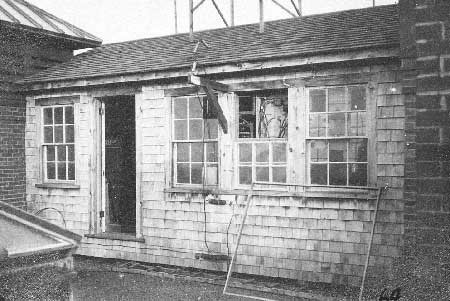 |
|||
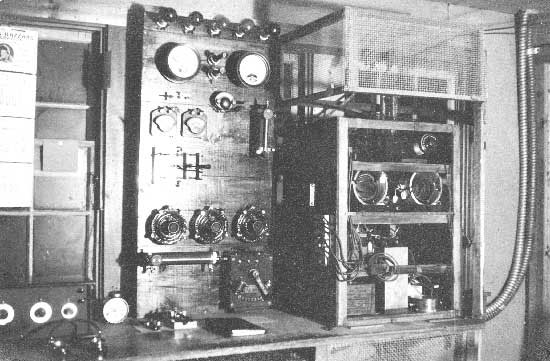 |
|||
|
The equipment shown here is inside the building shown above. There is enough visible of the calendars at the far left to conclusively date this photograph to 1924, most likely October. The transmitter is at the right. Unfortunately, the quality of the photo is not good enough to tell much about the transmitter, but it is definitely a higher power unit, perhaps about 1 KW. The transmitting key on the desk (just to the left of the book) is a high current key on a heavy marble base appropriate for a higher power spark transmitter. In the center is the power control panel for the transmitter which includes starting controls (lower right) for the motor generators shown below. At the far left is a receiver. None of the equipment shown here appears to have been commercially made. In 1925, this installation evolved into a broadcast station, WDCH. According to legend, the first words broadcast from this station were "Shut the god damn door!". Somehow, that seems entirely appropriate for a college station! |
|||
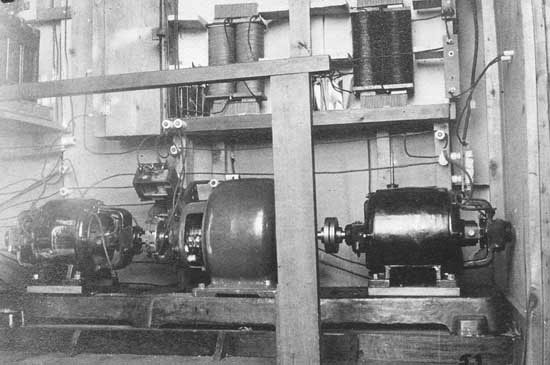 |
|||
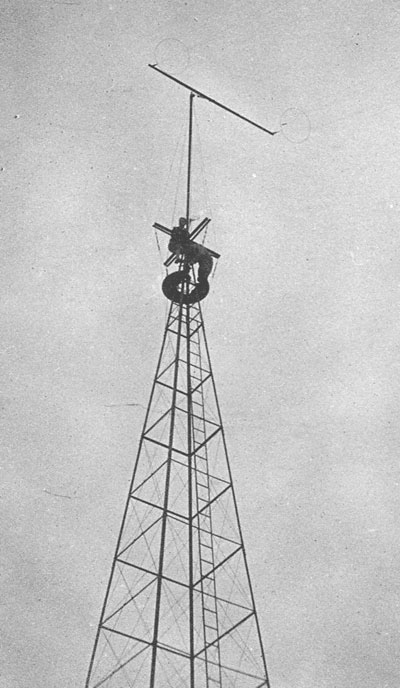 |
|||
|
Working on the antennas. |
|||
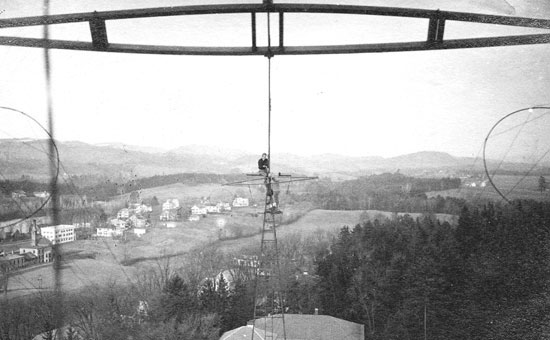 |
|||
|
Looking out over the mountains of New Hampshire. What a fantastic view! Also, compare this picture with the other views of these antennas. The picture was taken from the very top of the tower, not the platform! |
|||
| In the spring of 1925, 8BNY acquired a first class commercial radio operator's license, and for the summer of 1925 he served as radio operator aboard the USS Newport. The Newport was commissioned in 1897 and saw duty in the Spanish-American war. From 1906 onward she was operated exclusively as a training vessel. In 1921, she came under the control of New York State, and was used by the New York Public Marine School. |
USS Newport |
||
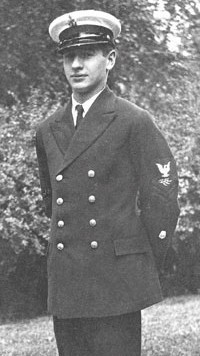 |
 |
||
| After graduation from Dartmouth, 8BNY joined the U.S. Navy. The rating badge on his uniform sleeve shows his rank as Chief Petty Officer, and the sparks show him as a radio operator. He remained active as a ham radio operator, and also held various commercial radio operator licenses throughout the 1930's. Not much of any equipment he might have owned has survived (at least, in my possession), but he was the former owner of the Wireless Specialty Eaton Oscillator. | |||
